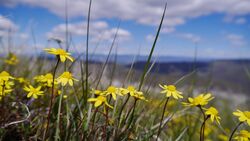Biology:Crocidium multicaule
| Crocidium multicaule | |
|---|---|

| |
| Crocidium multicaule on Umptanum Ridge near Yakima River, Kittitas County Washington | |
| Scientific classification | |
| Kingdom: | Plantae |
| Clade: | Tracheophytes |
| Clade: | Angiosperms |
| Clade: | Eudicots |
| Clade: | Asterids |
| Order: | Asterales |
| Family: | Asteraceae |
| Genus: | Crocidium |
| Species: | C. multicaule
|
| Binomial name | |
| Crocidium multicaule Hook.
| |
Crocidium multicaule is a species of flowering plant in the daisy family known by the common name spring gold.[1][2]
Description
Crocidium multicaule is a small annual, typically not exceeding 30 centimetres (12 in) in height when in flower. It grows from a low small patch of somewhat fleshy leaves at the ground and erects several tall thin stems, each of which is topped by a single flower head. The flower head is made up of five to 13 (usually 8) lemon yellow ray florets, each up to a centimeter long. The center of the head is filled with tiny disc florets, in a similar shade of bright yellow. The fruits are fuzzy brown achenes only one or two millimeters long which turn gluey when wet.[3]
Range and habitat
Crocidium multicaule is native to western North America from British Columbia to California , where it can be found in varied habitats from grassland to woodland, mostly in dry open habitat.
Gallery
References
- ↑ Hooker, William Jackson. 1834. Flora Boreali-Americana 1(suppl.): 335 description in Latin, commentary and figure captions in English
- ↑ Hooker, William Jackson. 1834. Flora Boreali-Americana 1(suppl.): plate CXVIII line drawing of Crocidium multicaule
- ↑ Flora of North America, Vol. 20 Page 641 Crocidium Hooker, Fl. Bor.-Amer. 1: 335, plate 118. 1834.
External links
Wikidata ☰ Q5187279 entry
 |




